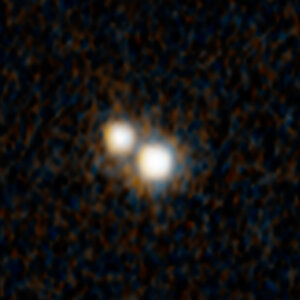
Hubble Observes oldest star-forming Cluster
FINDING THE ASHES OF THE FIRST STARS
Hubble zooms on the sky (0:39)
A new observation by the Earth-orbiting NASA/ESA Hubble Space Telescope has profound implications for the understanding of the earliest years of our Universe.
A team led by the astronomer Wolfram Freudling has revealed that the first stars in the Universe were formed only 200 million years after the Big Bang. Several hundred million years earlier than previously thought.
The team used Hubble's infrared instrument NICMOS to observe light from some of the most distant, exotic and ultra-luminous sources known to mankind: quasi-stellar objects, sometimes known as quasars.
Hubble's position above the atmosphere allows it to observe infrared light normally obscured by the Earth's atmosphere and unavailable to Earth-bound telescopes.
Animation: From first stars to the quasars (0:42)
Information about the very first generation of stars has been one of the Universe's best-kept secrets. When the first stars ended their lives as supernov
HEICO312
10:00:40
Hubble zooms on the sky:
1. sky map showing the stars as seen by the naked eye (data from ESAÕs Hippacos satellite)
2. 1.67 degree image from Digitized Sky Survey 2
3. The Hubble Space Telescope image (NICMOS camera)
10:01:19
Animation: From stars to quasars
10:02:01
Interview 1 Wolfram Freudling (European Southern Observatory): About the significance of finding iron in very distant galaxies in the early Universe.
10:02:33
Interview 2 Wolfram Freudling (European Southern Observatory): About being the first to find elements created in the first generation of stars.
10:02:45
Animation: The revised history of the Universe
10:03:33
Astronauts repairing Hubble's NICMOS camera during Servicing Mission 3B
10:03:56
END A-ROLL
B-ROLL
10:04:04
A-roll animations: ? Hubble zooms on sky ? From stars to quasars ? Scientist interview 1 ? Scientist interview 2 ? Repair of the NICMOS camera
10:07:18
Stock footage of the NASA/ESA Hubble Space Telescope
10:10:51
END B-ROLL






